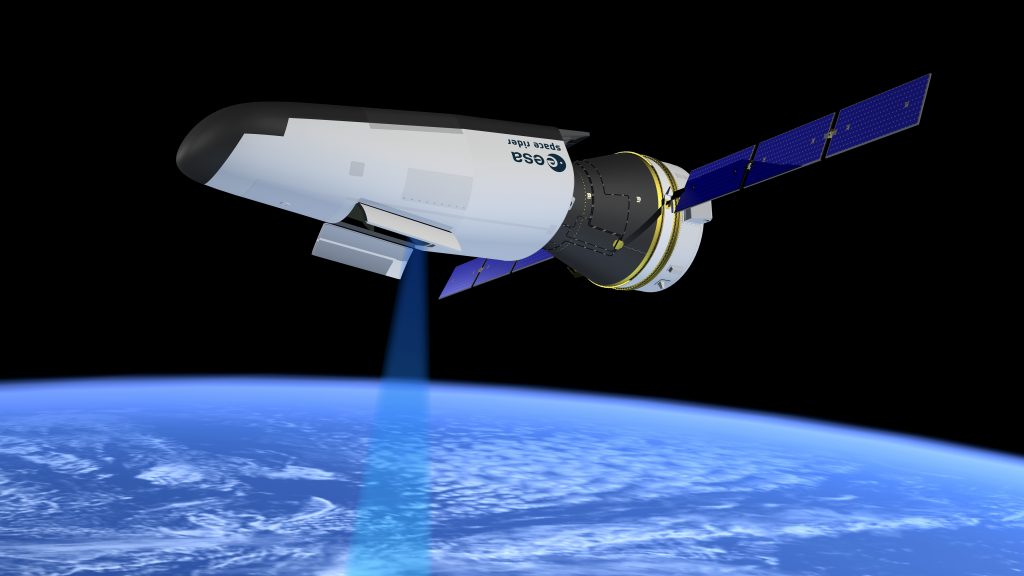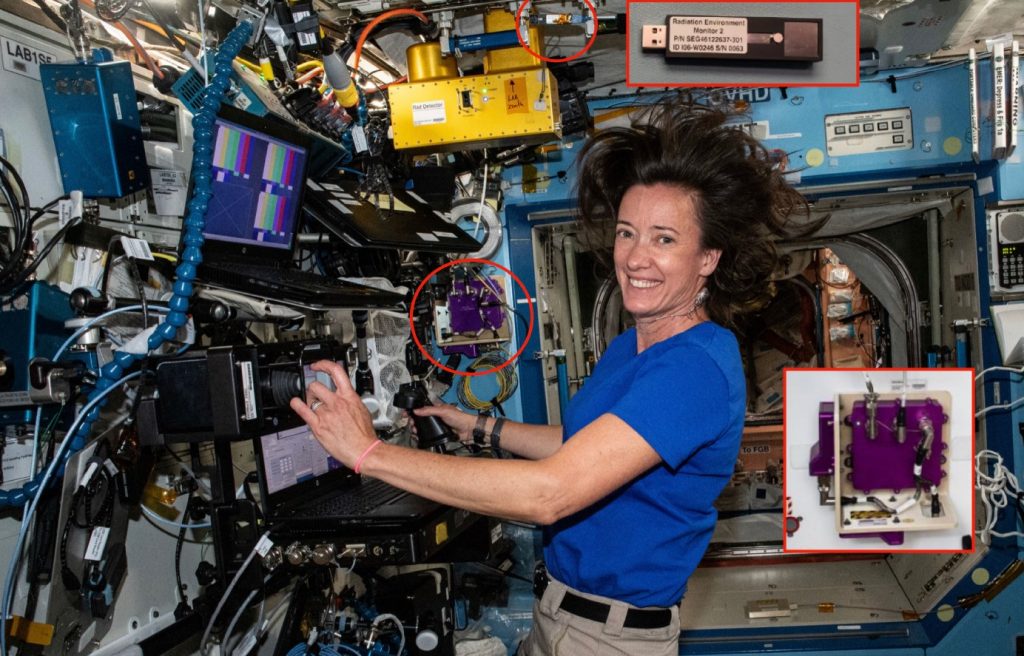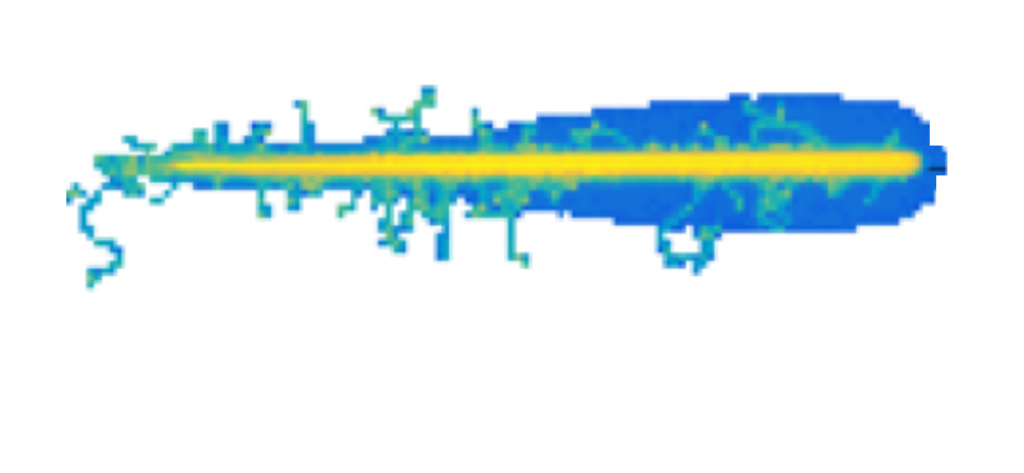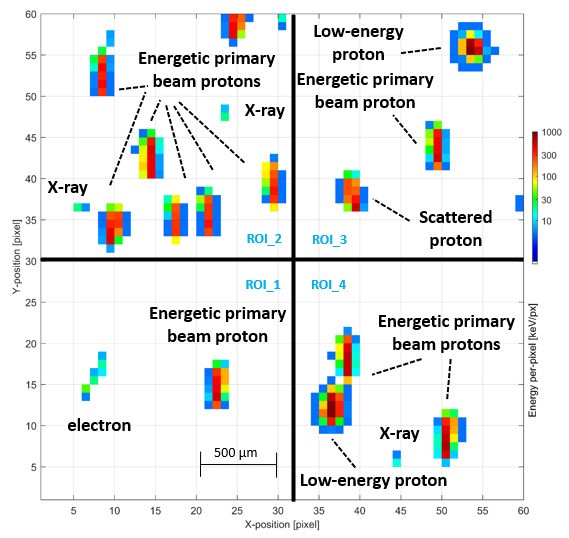SPACE WEATHER MONITORING
Charged particles from solar flares and coronal ejections can harm astronauts‘ health or induce damaging electrical currents in the spacecraft‘s sensitive electronics. Our miniaturized low-power consumption radiation cameras can help to prevent this damage, as they can track every particle and determine its type, energy, and angle of incidence.
High-energy particles, primarily protons or cosmic rays, can penetrate spacecraft and pose significant health risks to astronauts. Similarly, space weather phenomena can adversely affect the electronics of satellites or space stations.
For these reasons, Space agencies, including NASA and ESA, and our commercial customers have integrated ADVACAM’s radiation monitors into their spacecraft, probes, and satellites.
Furthermore, by identifying each particle’s type, our cameras provide space weather forecasting. The Sun’s lighter and less harmful particles arrive on Earth up to 30 minutes ahead of the heavier, more dangerous ones, providing a valuable window for protective measures to be activated, including shutting down critical onboard systems as required.
Our data-processing software, TraX Engine, was developed in cooperation with ESA to identify the properties of each particle. Possessing the capability to determine the direction of incoming radiation, our detectors play a pivotal role in optimizing protective shielding. Particularly useful when only one side of a vessel can be shielded, they allow for timely adjustments to incoming threats.
Our detectors, with its low power consumption of only roughly 2 watts and weight in the order of tens of grams, are ideally suited for integration for the demanding requirements of the space industry.
ADVACAM introduces a previously unseen technology for predicting cosmic weather. This technology provides timely warnings against increased solar activity, which can pose risks to the health of astronauts and disrupt the functionality of sensitive onboard electronics in satellites and spacecraft. Now, ADVACAM is bringing a new ambitious dimension on how to use their detectors: aiming to predict so-called cosmic weather and introducing NEW LEVELS of its monitoring.
PARTICLE TRACKING IN SPACE
Our radiation monitoring cameras can visualize each charged particle that impacts the detector’s surface. Each particle leaves a unique track or imprint, enabling us to determine its composition, spectrum, and direction with our data-processing software. Each particle type has different effects. Some are almost harmless, while others can significantly damage the human body or equipment. The ability of our cameras is unique compared to traditional radiation monitoring devices.
The effectiveness of Timepix detectors in characterizing space radiation and mixed radiation fields has been demonstrated through their use in multiple space missions. These include the International Space Station, the SATRAM payload aboard the ESA Proba-V satellite, VZLUSAT cubesats, and even the Artemis-I mission to the Moon. A Timepix detector was integrated into the HERA Radiation monitor onboard NASA’s Orion spaceship in the latter.
The detectors can quickly identify particle-event types, such as light and heavy charged particles, X-rays, gamma rays, or neutrons. For example, protons usually appear as broad, straight tracks because of their larger mass, while electrons form thin, long, curved tracks. Low-energy electrons register as small tracks, and X-rays appear as minuscule dot-like tracks spanning just a few pixels.
ADVACAM has also developed innovative software solution for real-time particle characterization called the TraX Engine. It allows for versatile and comprehensive analysis of particle data.
RADIATION DATA FOR YOUR SPACE EXPERIMENT
Thanks to their compact size, ADVACAM detectors are well suitable to be integrated for various space experiments.
Radiation data can be relevant for experiments in many fields, such as biosciences, pharma and tech. The effects of space particles on different materials and components remains still largely undescribed, which is why many companies need to test their products before introducing them to the market.
An excellent example of our MiniPIX SPACE detector used to measure radiation data is integration with Space Application’s International Commercial Experiment Cubes systems. The ICE Cubes are complete sets allowing companies and scientists to perform experiments on the ISS from the ground.
Another of ADVACAM’s partners, Vector Space BioSciences, is set to launch multiple satelites to document the impact of radiation on different biomaterials. The first launch is scheduled for 2025 and will include about 50 Tardigrades along with the Timepix2. Each individual payload will generate high-value data to be further analysed.
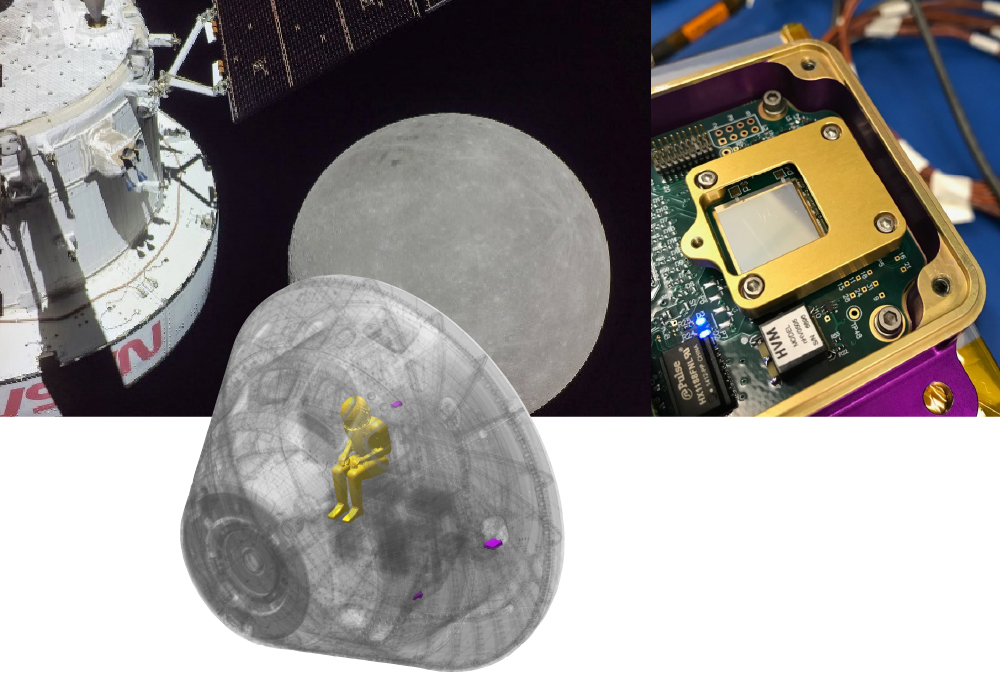
In the upper left image there is the far side of the Moon visible just beyond the Orion spacecraft. The upper right image highlights the HERA radiation monitor, equipped with ADVACAM’s Timepix chip module in the golden frame. The bottom image reveals how all the components of the Hybrid Electronic Radiation Assessor were incorporated into the Orion spacecraft.
ARTEMIS I: BACK TO MOON WITH OUR CAMERAS
NASA incorporates our Timepix chip module into its ambitious Artemis missions, which aim to return humanity to the Moon.
Artemis I, an uncrewed Moon-orbiting mission, was successfully launched on November 16, 2022. The mission’s primary objective was to conduct a Moon flyby, thereby testing the Orion spacecraft, which included NASA’s Hybrid Electronic Radiation Assessor (HERA). The HERA system, a cutting-edge radiation detector designed by NASA and equipped with ADVACAM’s hybrid pixel detector technology, was fully integrated into the spacecraft.
HERA provided onboard analysis and displayed radiation dose rates, linking to an alarm and warning system that activated when a certain dose rate threshold was reached. The Orion spacecraft spent roughly three weeks in space, with six days dedicated to a distant retrograde orbit around the Moon. It came within approximately 130 km of the lunar surface and achieved a maximum distance from Earth of 432,210 km. Our chip-equipped HERA monitor will also be included in future NASA Moon missions Artemis II and beyond.
ISS: PROTECTING ASTRONAUTS AT THE INTERNATIONAL SPACE STATION
As an official dealer for NASA, ADVACAM has supplied the agency with dozens of its radiation monitoring solutions over the past decade. Many of these devices are currently active, contributing significantly to the safety of the ISS systems and its crew.
Smaller and lighter than preceding NASA radiation monitoring devices, systems based on Timepix technology are perfect for space exploration missions. The single-photon counting technology, developed originally for CERN’s Large Hadron Collider, enables NASA to collect data regarding the radiation dosage and the precise location of radiation as it hits the detector. NASA scientists can examine the radiation spectrum within exploration spacecraft, enhancing their understanding of how to safeguard the crew during deep space missions.
The initial testing of the Timepix solution on the ISS started in 2012. Timepix USB Lite Interface devices from the Institute of Experimental and Applied Physics in the Czech Republic were utilized for these tests. Five of these miniaturized detectors, each about the size of a USB drive, have been consistently collecting a stream of data relayed daily to the Mission Control Center at Johnson.
ADVACAM, a spin-off company from the Institute of Experimental and Applied Physics, delivered its first branded device to the ISS in 2017. ADVACAM’s Miniature Particle Tracker (MPT) was installed on the International Space Station to demonstrate its proficiency in determining the directional characteristics of charged particle energy spectra in space.
Subsequently, ADVACAM became an official supplier for NASA. Several other miniaturized MiniPIX Timepix single-photon counting cameras were certified and delivered to orbit in 2019, launched on the Cygnus NG-12 flight. These devices have been installed in ISS modules, including the US Lab, Cupola, Columbus, JPM, Node 1, and Node 3, as part of the Radiation Environment Monitor 2 (REM2).
Moreover, NASA integrated the customized Timepix technology provided by ADVACAM into the Hybrid Electronic Radiation Assessor (HERA). The flight spare for this launch collected data and conducted a 30-day comprehensive test aboard ISS in March 2019. Later on, the advanced radiation system was deployed on March 2, 2021, and is currently operational on the ISS. Its ultimate purpose, however, is to function on the upcoming Artemis missions to the Moon and beyond.
This animation depicts data from a Radiation Environment Monitor 2 (REM2) in the Destiny Laboratory of the International Space Station. The map on the left side shows the distribution of dose rates over approximately two months from this unit. The space station location corresponding to the data frame on the right is overlayed on top of the dose rate map. The animation updates approximately every minute along the space station trajectory showing high latitudes, South Atlantic Anomaly (SAA), and equatorial areas in the low-Earth orbit radiation environment. The SAA is where the Earth’s inner Van Allen radiation belt comes closest to the Earth’s surface, dipping down to an altitude of 200 kilometers. Video: Courtesy of NASA
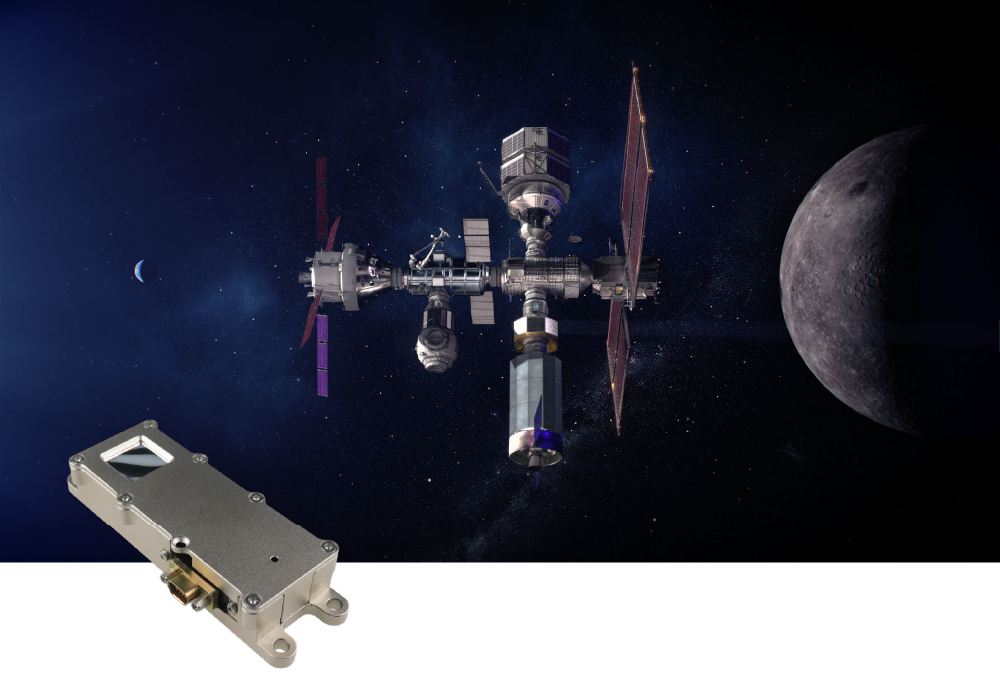
GATEWAY: SPACE RADIATION MONITORING AT THE LUNAR STATION
To the Moon and other planets! The Gateway Station, an international project led by NASA, is aimed to be the “gateway” to deep space. The aim is to prepare a manned flight to Mars and test new technologies. It will also be used for robotic and manned landings on the surface of the Moon.
ADVACAM and its detectors participate in European Radiation Sensors Array (ERSA) and International Dosimetry Array (IDA).
ERSA complements NASA’s Artemis program, which returns humans to the Moon. ESRA focuses on understanding cosmic and solar rays in unexplored areas as the orbital outpost is assembled around the Moon.
IDA will measure radiation levels coming from the Sun in the form of intense storms of solar energetic particles and galactic cosmic radiation, thought to originate from supernovas. The detection array will be inside the Habitation and Logistics Outpost (HALO). Measurements from IDA will complement external space radiation data to enable safer and more sustainable deep space exploration.
VZLUSAT-2 – CUBESATS INTEGRATION
Thanks to their super low power consumption of just around 2 watts and their tiny dimensions, our MiniPIX-based detectors are ready for integration even into the smallest Cubesats.
The Czech Republic has a solid scientific and technological base for space research. The cooperation of scientific workplaces and specialized companies led to the VZLUSAT-2 nanosatellite, designed and constructed at the Czech Aerospace Research Centre.
ADVACAM provided the mission with its state-of-the-art hybrid pixel detector MiniPIX TPX Standard. The VZLUSAT-2 nanosatellite has been successfully integrated into the deployer and launched as a part of the Transporter 3 mission onboard the Falcon 9 launch vehicle. The primary goal of VZLUSAT-2 is to verify technologies for future missions of the upcoming Czech satellite constellation. Among the onboard equipment is also a next generation of instruments which have already been proven on VZLUSAT-1, as well as several gadgets provided by Czech universities and private companies.
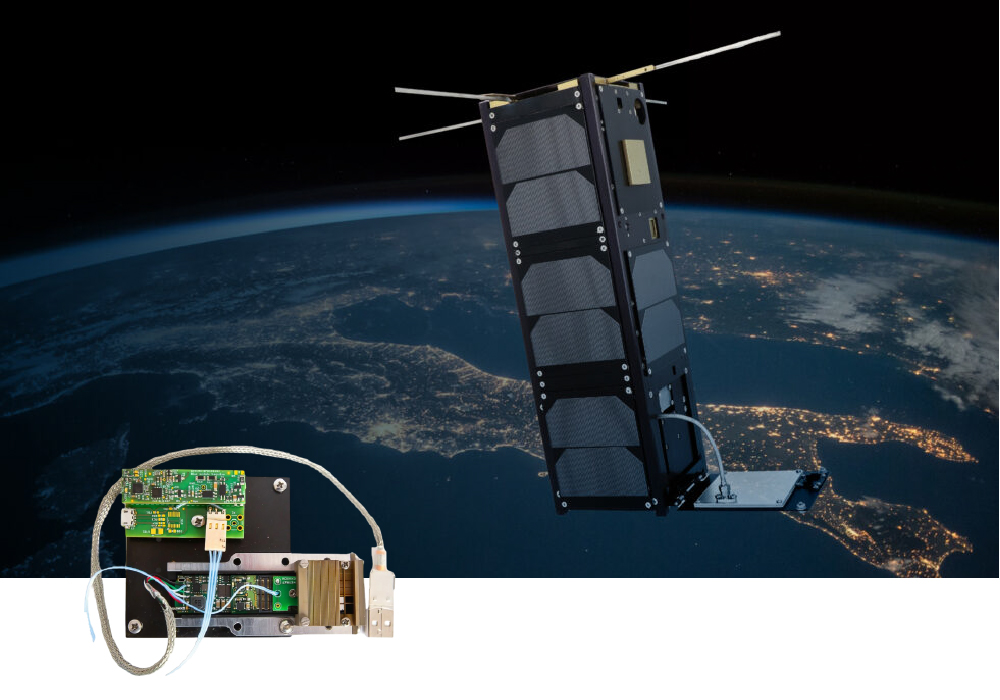
ONE WEB: SAFETY TO NEXT GENERATION OF SATELLITE INTERNET
Proving radiation monitoring for next-gen satellite internet constellation
The JoeySat project by OneWeb is a crucial innovation in satellite internet technology. The JoeySat, launched in 2023, is a demonstration device that introduces several advanced features to be included in OneWeb’s next generation of satellite internet constellation. It incorporates beam-hopping technology, allowing satellites to switch between Earth locations and adjust signal strength based on customer needs or demand.
JoeySat also houses a high-resolution radiation monitor developed by Advacam. This monitor is designed to detect, classify, and track cosmic rays and space radiation in orbit. As telecommunications satellites are constantly exposed to cosmic rays and space radiation, the ability to accurately monitor and classify radiation is critical. It aids in safeguarding sensitive onboard electronics, optimizing satellite operations, and enhancing the longevity and reliability of these space assets.
JoeySat and the incorporated Advacam technology are part of the Sunrise program, funded by the European Space Agency and the UK Space Agency. The program represents a collaboration between various innovation partners, including SatixFy and OLEDCOMM. As a part of the commercial space industry, Advacam is committed to providing tailor-made solutions for various space applications, conforming to the specific requirements and standards of the industry.
SPACE RIDER: EUROPEAN REUSABLE ORBITAL TRUCK
The Space Rider is supposed to be Europe’s first reusable space transportation system with ADVACAM cameras on board.
The Space Rider is an uncrewed robotic laboratory about the size of two minivans. It will stay in low orbit for about two months. Experiments inside its cargo bay are supposed to allow technology demonstration and benefit research in pharmaceutics, biomedicine, biology, and physical science. At the end of its mission, Space Rider will return to Earth with its payloads and land on a runway to be unloaded and refurbished for another flight.
ADVACAM detectors in a unique stacked configuration with CdTe sensors are dedicated to space weather monitoring, material radiation aging, and the influence of space radiation on commercial aircraft safety.
Space Rider is an outstanding example of European international cooperation under the umbrella of ESA with the participation of scientific workplaces and the commercial sector.
